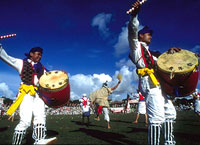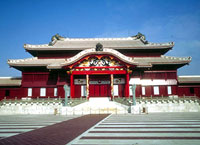|
|
|||||||
|
|
|||||||
|
|||||||
| | Web Japan >>| Trends in Japan >> | Arts & Entertainment >> | Dancing in the Streets | |
|
DANCING IN THE STREETS Summer Is Eisa Festival Time in Okinawa (August 13, 2003) August is a time when Okinawa basks in tropical sunshine and when the people of the islands participate in spectacular dance parades. Eisa festivals are thrilling summer events that blow away the heat and excite the souls of the Uchinanchu, as the people of Okinawa call themselves. At the festivals, people beat drums and sing songs to the sounds of the sanshin (an Okinawan string instrument); men perform a bold dance that incorporates karate moves, while women perform graceful dance moves. There is also the chondara procession dance, which never fails to bring smiles to the faces of spectators. Each of these dances has an essential role in the eisa festivals.
Partying Until the Early Hours Men dance with all their might, oblivious to the sweat pouring from their brows, and the sight of their brave performance touches the hearts of the women. The enchanting dances performed by the women, meanwhile, which feature intricate hand moves, captivate the men. There have been many cases of men and women finding love through eisa festivals, and there is even a local word - eisanibichi - for marriages that come about this way. Much of the beauty of eisa festivals derives from the brightly colored costumes that are unique to each locality. Some eisa troupes have retained their traditional costumes for over 300 years. The dance moves and music of the festivals also vary widely from place to place. Nowadays, eisa festivals are held all over Okinawa in August, with eisa troupes gathering to impress spectators with the dances they have spent many hours perfecting. These events are a highlight of summer sightseeing on the islands. The All-Island Eisa Festival, which is in its forty-eighth year and will be held on August 16 and 17 in Okinawa City, draws eisa troupes from all over Okinawa Prefecture and attracts more than 200,000 spectators. Eisa festivals continue until the end of August, including one featuring original eisa dances performed by young people in Naha City on August 23 and 24 and one featuring dances performed by children in Okinawa City on August 23. Traditional Arts Reflect Okinawa's Heritage The Ryukyu Kingdom continued to prosper as a trading nation, but from 1609 it was ruled by the Satsuma clan (modern-day Kagoshima) of Kyushu. After the Tokugawa shogunate fell and the Meiji government came to power in Japan, in 1879 the Ryukyu Kingdom was incorporated into Japan as Okinawa Prefecture, bringing an end to 450 years of history. Okinawa was the only part of Japan to experience a land battle in World War II, and some 150,000 Okinawans - about a quarter of the total population - died in the war, including from hunger and disease. After the war, Okinawa was ruled by the United States before returning to Japan in 1972, 27 years after the war ended.
An Exotic Atmosphere and a Unique Culture A good way to experience modern Okinawa is to walk down Kokusai-dori, the main street of Naha City. This street was the first to be rebuilt after the war and became such a vibrant commercial center that it earned the nickname "Miracle Mile." The citizens of Naha love passing time wandering among the area's department stores, restaurants, beer halls, souvenir shops, and cinemas. On a back street near Kokusai-dori is the Makishi Public Market. This is a bustling district where a maze of crisscrossing streets are filled with stalls selling all kinds of goods. Walking past rows of shops selling exotic tropical fruits and fish of extraordinarily bright primary colors, visitors might be forgiven for thinking they had stumbled into a market in Southeast Asia. Eisa and other traditional Okinawan arts are sustained by the unique melodies of the islands' music and have lost none of their originality. Thanks to this rich musical heritage, in recent years Okinawan songs and artists have had considerable success in Japan's pop charts. Okinawan culture is gaining increasing recognition for its exceptional color and vitality. Related Web SitesOkinawa Naha City Okinawa City Shuri Castle Copyright (c) 2004 Web Japan. Edited by Japan Echo Inc. based on domestic Japanese news sources. Articles presented here are offered for reference purposes and do not necessarily represent the policy or views of the Japanese Government. |
MIDSUMMER NIGHTS' REVELRY (July 22, 2003) RITES OF SUMMER (June 27, 2003) AN ISLAND SONG GOES BORDERLESS (July 3, 2002) |
|
|





